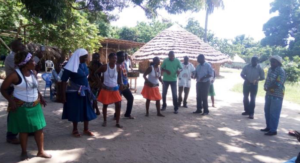To conclude the introductory module started by “Appreciative Discernment,” participants were presented the process of “Fallen Upward” of Richard Rohr by our facilitator James Shimbala, sma. It is a process which sees us stronger in intents after falls. This process of self awareness is not about removing or solving the problems rather, it is about moving on with the problems as strengths. Rohr, in his presentation, likened the first phase of our human life to a container. In this container, we have all we think we need and to be human and better in relationships. The container is made of: our ego, our identity, our behaviours which are possible responses to threat of life according to our personal worldview. These responses, we acquired from our immediate environments as information. However, our journey to greatness requires that we develop contents for that container, which can happen by our falling upwards, being open to the world around us and therefore, see things differently and from an integrated perspective. (“Fallen Upward “ is authored by Richard Rohr and has 14 chapters).
The objective of this process, from the presentation, is to encourage a positive transitioning in life’s journeys. “Transition” is a movement in life journey, from one phase to another. In life, there are folds of experiences. Some maybe positive while some negative. However, observations of journey of growth had shown that in most cases, we tend to get stuck in the negative experiences. Getting stuck in the negatives may not be considered as growth in the intent of being created for greatness. In transition, there are some major movements like: Denial; Shock; Anger; Bargaining; Depression; Disorientation; Acceptance
The achievement with this process, in the journey of growth, is to reach acceptance which is the fruit of positive transition. Some of the factors that may prompt us to express any of these ‘movements’ mentioned already are (to mention a few): Birth; Weaned; Leaving home; Mid-life; Transfer/Promotion; Disability; Accident; Death
- For one to achieve a positive transition, he or she has to
- Identify the fear and name it
- To be aware of some of its elements
- Keep moving approrpiately
However, our facilitator stressed that fear not positively ‘ befriended’ may become Trauma. A trauma is “ a severe shock or a very upsetting experience which may cause psychological damage.”
Post Traumatic Stress Disorder is a state of physical, mental or emotional strain resulting from adverse or demanding circumstances.
Stress is caused by
- Event that was out of control, where one feels helpless
- Serious danger to life (either own life or of Others)
- PTSD is dagnosed after 3 months. Before that, a person experiencing its symptoms is still likely to have the natural healing from them, so no need to diagnose them as such, though appropriate care is still necessary.
Some examples of experiences by persons who have been affected by a Traumatic Event:
- Nightmares
- Hallucinations
- Perceiving danger anywhere even when it is not objectively so serious
And it manifests in three main ways:
- Re-experiencing the traumatic event and its associated feelings. Survivors may be easily reminded of the event and they feel as if they were back there, being traumatized again. the memories are triggered by reminders, some of which may be even innocent sounds, smells, colors… that have some similarity to those associated with the traumatizing event.
- Hyperarousal: experiencing very strong feelings / emotions like rage and terror.
- Avoidance situations where they may be reminded of the traumatic event or where theymay experience the hyperarousal. e.g. Fear falling asleep; Phobias; Avoiding Public places
To positively manage “ trauma debriefing “, these timings have to be considered:
A. Tell the story of positive experience before the event of trauma. C. Tell the story of the time of the event of trauma
B. Tell the story of after the event of trauma (‘it is over’)
All story telling in the journey of growth shall include feelings, emotions, bodily sensations, acts, environment, thoughts and interpretations thus, bringing the experience to “here and now”. In following this process, it may help the victim to be aware that the hurting experience is simply part of the whole of the person.
Also, a Helping attitude on the part of a helper was proposed by the facilitator. This consists of:-
- To have a sense of safety
- Context of here and now(real stories)
- Story be told in a heathy way (as survival and not a victim).
At various points in the presentation of the different movements for positive human integration, appropriate exercises were introduced and practiced. As part of the process of creating a helping attitude in us, the participants, that the facilitator led us in a picnic to the Traditional Museum and Historical places in Dar Es Salaam.
The experience of these visits opened the doors to the process of Bereavement. Bereavement is a period of mourning and of grief after a loss of a loved one.” Grief is a feeling that comes after a particular loss “. The author chosen by the facilitator to guide us in this regard was Elizabeth Kubler Ross.
Bereavement has these phases:
1. Denial/ Shock; 2. Anger/Guilt; 3. Bargaining; 4. Depression; 5. Acceptance/ Moving on
However, we were reminded by the facilitator to be aware that the phases are not linear. Thus, a person should not be forced to make the experience in a linear form.
Remarks on Process of Bereavement.
- Process is not linear
- Not all victim go through all at the time.
- Not rational all the time
- Appropriate expression of experiencing enables moving on
- Express your story, behaviours, feelings, sensing, images, thoughts and relationship andphysical health.
As a victim, in order to positively make a meaningful transition then there is need to be aware
- Take time to mourn
- Feel and express what you feel
- Do not rush to reach acceptance
- Attend the goodbye of a beloved
- Let the Word of God light the way
- It is OK to cry
- Not obliged to copy others’ style
- Do exercises for relaxatio n
- Get/ Accept social support
- Hope
- Individuation/Uniqueness
- Forgive
In summary, the processes presented so far are tools to help us transformation in our journey of growth. However, to positively benefit of them, we need to identify, acknowledge and appreciate our wounds, that is, areas of weakness yarning for transformation. In this note, our facilitator wrapped up the introductory module module with the presentation of Existential Process of transition. For the Existentialists, there are for conditions for transition namely:
1) Inevitability of Death; 2) Lonelinesses; 3) Responsible Freedom; 4) Meaninglessness.
To better understand this module, an exercise was given and it was to write and share with a partner, 25 attributes of self on who am I ? and what am I ?
Created by ICOF Media Team, February 2018.





